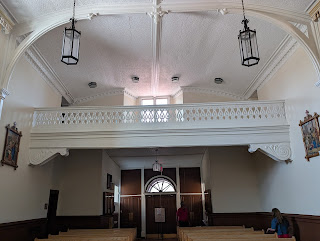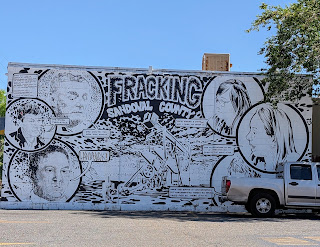
As I mentioned previously, Steven and I had made New Mexico's largest city, Albuquerque, a pitstop a few times on our other road trips. Still, we'd never thought of stopping to see what it had to offer until this very belated road trip through the Land of Enchantment. I'm positive you'll agree we made a wise decision in rectifying that mistake finally!
Though Albuquerque, or ABQ for short, has long labored under the shadow of the tourist meccas of Santa Fe and Taos an hour to the north, it proudly describes itself as living in the "City Indifferent," unconcerned with fads and fanciful facades! ABQ was founded three centuries ago by a Spanish nobleman, hence the nickname "Duke City." The city's character was defined by the arrival of the railroad in 1880, which revitalized the downtown district, the early 20th-century University of New Mexico campus built by John Gaw Meem, the architect who defined Pueblo Revival style, and Route 66, the highway that linked ABQ to Chicago and Los Angeles in 1926.
We began our exploration of the city at the ABQ BioPark, which comprised an aquarium, botanical garden, and heritage farm, all linked by parkland along the Rio Grande. Janina: You'd have loved this bench at the aquarium's entrance.
These imaginative doors were an unusual introduction to the aquarium.
I could have sworn that the stingrays kept coming up to the glass and staring at us!
Diamond terrapins were a popular gourmet food in the 1900s, but overharvesting led to a rapid decline in their numbers. Though now protected in many states, current threats include rising sea levels, coastal development, habitat loss, strikes by motorboat propellers, and the pet trade. Female terrapins crossing roads in search of nesting sites are often killed by cars.
The actual size of a Great White Shark:
I looked above us at the Atlantic Coral Reef exhibit and noticed the scuba diver! He wasn't nearly as colorful, however, as the brilliantly colored fish below him.
There was an impactful discussion about whether great white sharks can continue to survive after roaming the world's oceans for 400 million years, given that overfishing, trophy hunting, naturally slow rates of reproduction, and a practice called shark finning have alarmingly reduced their numbers.
I loved watching these Moon Jelly blobs float around the tank!
I was not impressed that while looking for books for our grandchildren in the gift shop, the price in Canadian currency was listed in pounds, rather than dollars. That was a first!
The Garden Entrance:
I loved the fluffy blooms on the Golden Trumpet trees.
The Spanish Moorish Garden:
The Jardin de Redondo Memorial Garden:
I wondered if the girl was having her quinceañera photos taken?
If we return to New Mexico next year, as we hope, we'll have the opportunity to see the new Lebanon and Beyond Garden, which is designed to bring Lebanon's and the Mediterranean's landscapes, architecture, and cultural richness to Albuquerque.
The image reminded me of the Little Mermaid sculpture outside of Copenhagen!
Beyond the pond was the Botanic Garden.
Are you as much of a fan of miniature train sets as I have been since seeing one in Phoenix a few years ago? Too bad some of our grandchildren couldn't have been with us, as I would have loved to see their excitement when they spotted Thomas the Tank Engine and the other locomotives travel the large track.
We explored the Desert Conservatory next.
This was my first time spotting a Ponytail Palm, which is native to southeast Mexico. Have you seen one before?
I wonder if Steven and I will ever be lucky enough to view a Madagascar Palm in its native land.
The Rio Grande Heritage Farm was a recreation of a 1930s operation with heirloom orchards and rare types of livestock in an idyllic setting near the river.Earlier in this trip, I was surprised to learn that North America's first vineyards were established in New Mexico in the 1600s, not in California, as I had previously thought. The Spaniards brought mission grapes with them to make wine for religious ceremonies.
I'd have liked to see the farm's rare Navajo-Churro sheep, as I'd read that they are a sacred animal for the Navajo and have provided people with food and clothing needed to survive for centuries. If I could have rolled back the years to when I was about eight, I like to think I'd have jumped right into the farm's Mud Art Zone!The Weeping Blue Atlas Cedar was almost impossibly furry for a fir tree.
Of a hundred places in the world where I expected to see my first Cell Phone Recycling Box, Albuquerque would not have made the list. The box described how mining coltran is destroying rainforests in the Democratic Republic of the Congo, which are home to indigenous people as well as a variety of plants and animals, and that recycling cell phones and other electronics is an easy way to make a difference.
I was hugely surprised by ABQ BioPark, and I am already looking forward to returning there next year!
Such fancy entrance gates to the Sculpture Garden at the Albuquerque Museum!
The Hórreo was a traditional structure from northwest Spain and northern Portugal, dating back to the 13th century, used to store and keep grain and root vegetables dry. I wouldn't have thought of it as a sculpture, but I was intrigued by its religious significance.
A bronze head of Cervantes:
Images from the front of the museum:
The entrance to the city's Old Town was only a few steps from the museum.
Car buffs would have loved the old cars displayed by the ABQ Car Club on the Old Town Plaza. In the background was the San Felipe de Neri Church, which was originally built during the Spanish Colonial period on the other side of the plaza until it dissolved in a puddle of mud in 1792.
Since the church, the oldest in Albuquerque, was initially founded by Franciscan friars in 1706, it has been served successively by the secular clergy of Durango, Mexico, in 1817; the Jesuit fathers and brothers in 1868; and, since 1966, by the secular clergy of the Archdiocese of Santa Fe.
I don't think the replacement church will fall apart, since its six-foot-thick walls were made of adobe-like terrones, or sun-dried bricks cut from natural sod along the Rio Grande.
Masses are offered three times a day, once in Spanish. That was more than any church I've visited in a long time.
The church's original wooden ceiling was covered with pressed-tin tiles in 1916.
People walking around the plaza that Sunday afternoon were treated to a lovely selection of jazz standards by a concert band in the gazebo.
Another nearby plaza:Other images from the attractive Old Town:East of Old Town was the Downtown district, once known as bustling New Town, and home to historic Route 66 along Central Ave. since 1937, when the route was moved. The city's most distinctive building was the ornate KiMo Theatre, built in 1927 in the new Pueblo Deco style, a flamboyant treatment of Southwestern motifs, similar to the Moorish- and Chinese-style cinemas of the era. The name meant "king of its kind."
The traditional Navajo symbol in the center had not yet been appropriated by Germany's Nazi Party when KiMo was built.
Even though we were there when there should have been a tour of the theatre, it was closed. It was as well, as there were some men down on their luck out front. Instead, I peeked through the windows for a moment.
See the Route 66 sign under Central Avenue's name...
... and another one, here.
Be sure to click on this picture to make it bigger, so you can read the book titles - they're an absolute hoot!
If you've been following the blog for a while, I'm sure you're aware of how much Steven and I are drawn to murals when we tour new cities.
The Freedom of Expression mural seemed particularly poignant, given the current state of the country's political climate.
Another of the city's gems was the Occidental Life Building, which was built in 1917 by H.S. Trost, the architect whose work we recalled as defining downtown El Paso. Its ornate facade of white ceramic tiles brought to mind the Doge's Palace in Venice, albeit with more frills!
The neon-trimmed gate on Central and Girard welcomed people to the start of Nob Hill, an area that began to flourish in 1937 when Route 66 was relocated to run along Central.
The Nob Hill neighborhood hit the big time when it opened the glitziest shopping plaza a decade later.
A few blocks off Central was the Bart Prince House, also affectionately known as The Spaceship and as The Bughouse! Home to one of the city's most celebrated contemporary architects, and a protégé of Frank Lloyd Wright, it fit right in with the eccentric businesses that now make up Nob Hill.
Off to one side was a Spaceship House Dinosaur!
When the University of New Mexico, the state's largest, was established in 1898, it was just a tiny outpost on the far side of the newly opened train tracks. The school's oldest buildings were constructed in a distinct pueblo-inspired style and were commissioned in the early 1900s. The style was carried through to the university buildings designed by Meem in the 1940s and early 1950s. One example was University House, which was built in 1930 and was a Registered Cultural Property of New Mexico.
Another classic Meem building on campus was the old wing of the Zimmerman Library.
Even the library's contemporary addition looked remarkably harmonious.
I'm curious if the UNM is the only institution of higher learning in the country to have a Kiva.
Next post: 20,000 Petroglyphs & Sandia Peak Tramway!
Posted on July 3rd, 2025, from our home on the eve of Independence Day. About an hour ago, Steven and I finished helping to staff the fire line at a local park to ensure everyone's safety from tonight's fireworks. A major perk was front-row seats for the festivities! If you're in the U.S. during the holiday weekend, enjoy yourself, but please keep an eye out for those around you.
































































































Delightful is how I would describe this post and hence Albuquerque. I loved the mural artistry, the quaint old town and the iconic “ Route 66” signage . And , as someone who visits any aquarium I find , I loved the photos of the colourful and enchanting marine life. And the lady dressed in the glorious red gown, is stunning . Xo Lina en route home from the island of Green Gables fame .
ReplyDeleteYou're so right, Lina, that there was lots to see and do in ABQ that piqued our interest, and has already made it to our itinerary for a return trip to NM next year, God willing! Safe travels home - too bad your road trip was so short this year. Love to you and Dan.
DeleteOne other side note … my introduction to Albuquerque , NM was via the series “ Breaking Bad” which , I believe, was filmed there . Your blog provided so many more interesting city facts and features. As always, thanks for the tour . Xo Lina , still on the highway home Xo
ReplyDeleteYou're absolutely right that "Breaking Bad" was filmed in ABQ, Lina. I had a list of sights related to the film, but we never got around to seeing them. Perhaps, next year! XOXO as always!
ReplyDeleteAbsolutely; there is always next year !
DeleteAlways fun to have something to look forward to, Lina!
DeleteYes, it is a great bench!!! Janina
ReplyDeleteGlad you liked it!
Delete